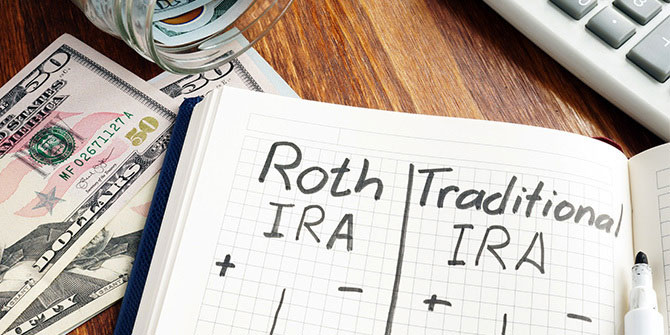Aug 12, 2022 By Susan Kelly

It's possible to offer your children or grandkids tax-free savings for longer if you contribute to an individual retirement account. It's a present that keeps on giving. A tax-deferred retirement savings vehicle, the IRA is a type of IRA. However, unlike the employer-sponsored 401(k) plan, this one does not require an employer to create the account; instead, assets can grow tax-free until they are withdrawn.
Gifted IRA Contribution Requirements and Limitations
It is still required for the beneficiary to complete the eligibility requirements to contribute to their own Individual Retirement Account (IRA). Additional criteria for a Traditional IRA include:
- Traditional and Roth IRA contributions combined cannot exceed $6,000 per year for an individual.
- A person's annual taxable salary cannot be more than the total of the individual's contributions.
- Deductions are limited if the individual or their spouse is enrolled in a retirement plan at work and their income reaches a specified threshold.
Contribution Limit for Spouses

Married individuals filing a joint tax return can utilize their spouse's earned income to calculate their contribution limits. Assume, for example, that you are a stay-at-home parent earning $80,000 a year while your spouse works outside the home. This sum allows you to contribute $6,000 to an IRA for a total of $12,000—well below the $80,000 your husband earns. You might donate up to $7,000 if you're over 50.
Making IRA Contributions as Gifts to Minors
When you create an Individual Retirement Account for your kid or grandchild, you can reap several benefits. As an adult, you'll need to set up a custodial Individual Retirement Account (IRA) for a minor, which you'll be responsible for until the kid reaches the age of 18 or 21, according to the state.
You can contribute to your kid or grandchild's Individual Retirement Account. But it can't exceed the yearly limit of $6,000 or the child's earned income. You don't have to deposit your child's money into the IRA. They can originate from you, the author. On the other hand, an IRA cannot return funds to the custodian.
Examples of Contribution Limits

You'll need to consider their annual earnings if you contribute to your teen's Individual Retirement Account (IRA). You can only contribute $3,500 to their IRA if they earned $3,500 from after-school employment. If you have the means, you might consider matching your teen's earnings in an IRA dollar for dollar to teach them the importance of saving.
Will My Child's Individual Retirement Account Contribution Be Accepted?
For gifts in 2021, the yearly exclusion for each recipient is $15,000 per year, rising to $16,000 in 2022. Because this contribution is more significant than the maximum allowable IRA contribution, you will not be subject to gift tax on your IRA contribution gift. However, it will count toward your yearly exclusion for gifts to your kid.
No taxes will be owed even if you give more than the yearly exclusion amount. You would need to record the excess over the yearly gift exclusion threshold on your tax return. In 2021, the lifetime gift exclusion is $11,700,000, and in 2022, it is $12,060,000.
Can I Contribute To My Kid's IRA If They Don't Work?
Non-taxable remuneration, commonly known as earned income, is required for the IRA owner. Taxable remuneration includes wages, commissions, tips, or income from self-employment. 71 You can't contribute to an IRA on behalf of your child if they don't have any money coming in.
Unearned income, such as pensions and annuities, cannot be deducted from your IRA contribution. Pensions, unemployment benefits, and Social Security are all examples of unearned income. As a rule, if your child is married and files a joint return with their spouse earning enough money, this regulation does not apply to them.
Is a Traditional IRA Or A Roth IRA Better For My Child?
Your family's tax condition, both now and in the future, has a bearing on this. Traditional IRAs are financed with pre-tax money; Roth IRAs, on the other hand, are funded using after-tax monies. As a result, when your child withdraws cash from a Roth IRA in retirement, they will not be taxed on the money.
When deciding which sort of IRA to use, you should consider whether your child would be better off paying taxes in retirement or withdrawing assets tax-free. The $6,000 Roth IRA contribution cap and earned income criteria are the same as conventional IRA accounts.
Summary
Begin by familiarising yourself with the rules for contributing to a child or grandchild's Individual Retirement Account (IRA). A custodial account must be opened if the recipient has not yet reached the age of majority. FAFSA doesn't consider this information when determining if a student is qualified for financial assistance, so this is excellent news. Contributions are limited to the amount earned by the beneficiary in that tax year.
-

The inevitable trend of the development of things
May 24, 2021
-

CFA vs. CFP: Which Is Better For You?
Jun 07, 2023
-

Ways to Open a Savings Account
Feb 20, 2023
-

Online Broker for Beginners
Jan 14, 2022
-

See How: Is It Possible to Retire at 45 With $500,000?
Jul 23, 2022
-

Refinancing 101: Should You Refinance Your Student Loans?
Jun 14, 2023
-

How to Buy a Foreclosed Property
Jul 03, 2023
-

Is Stock Investing Profitable for You
Aug 03, 2022


